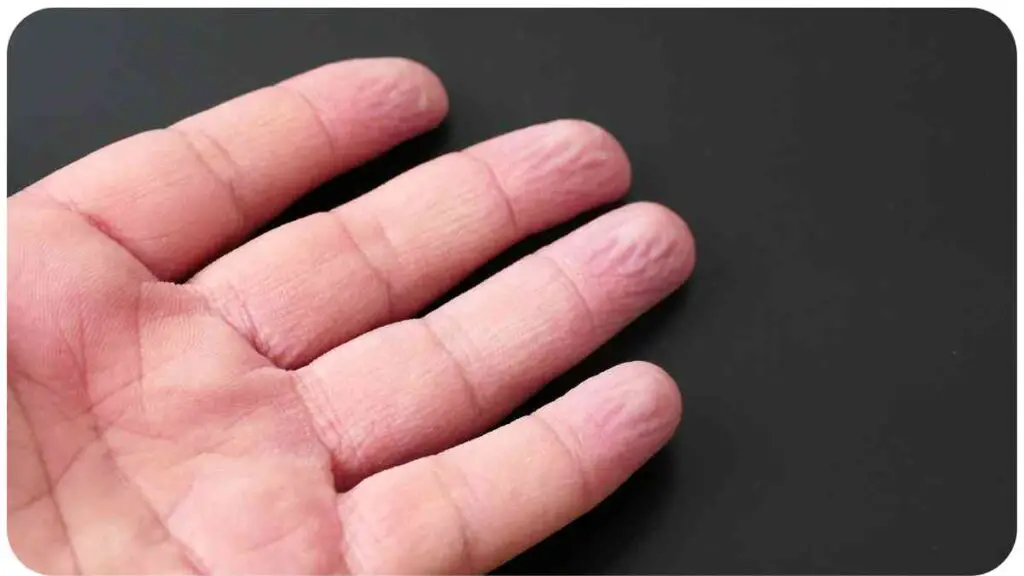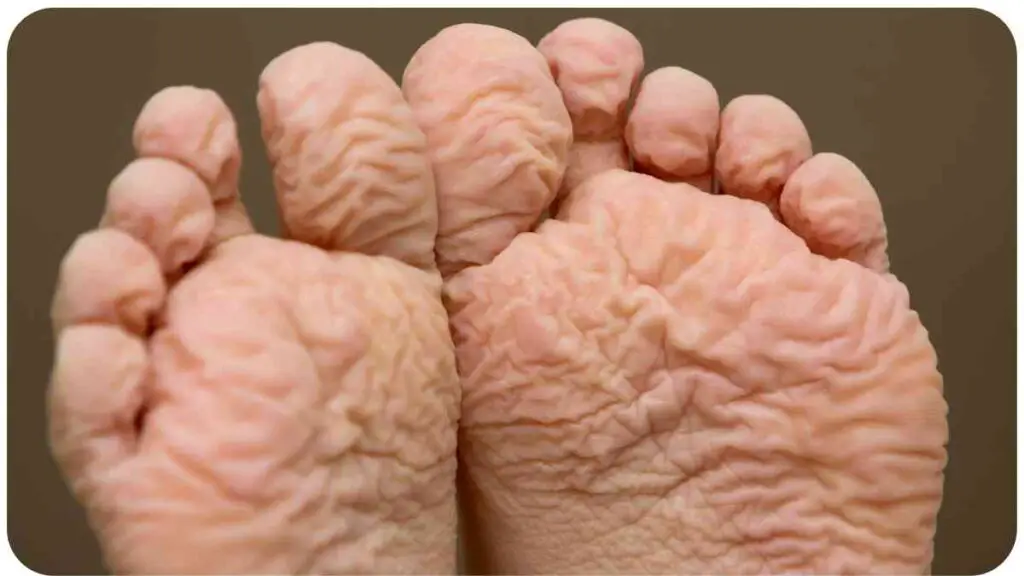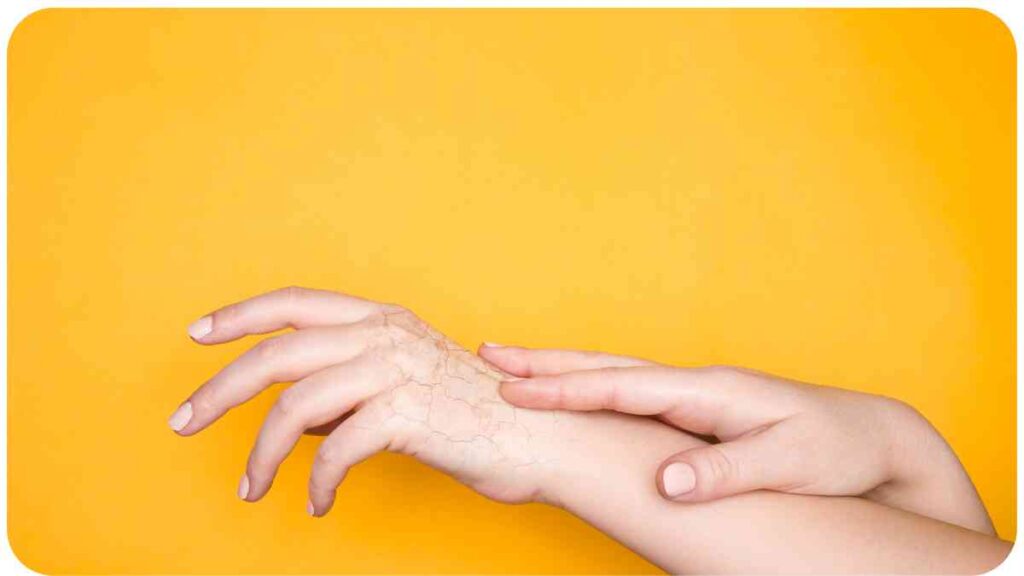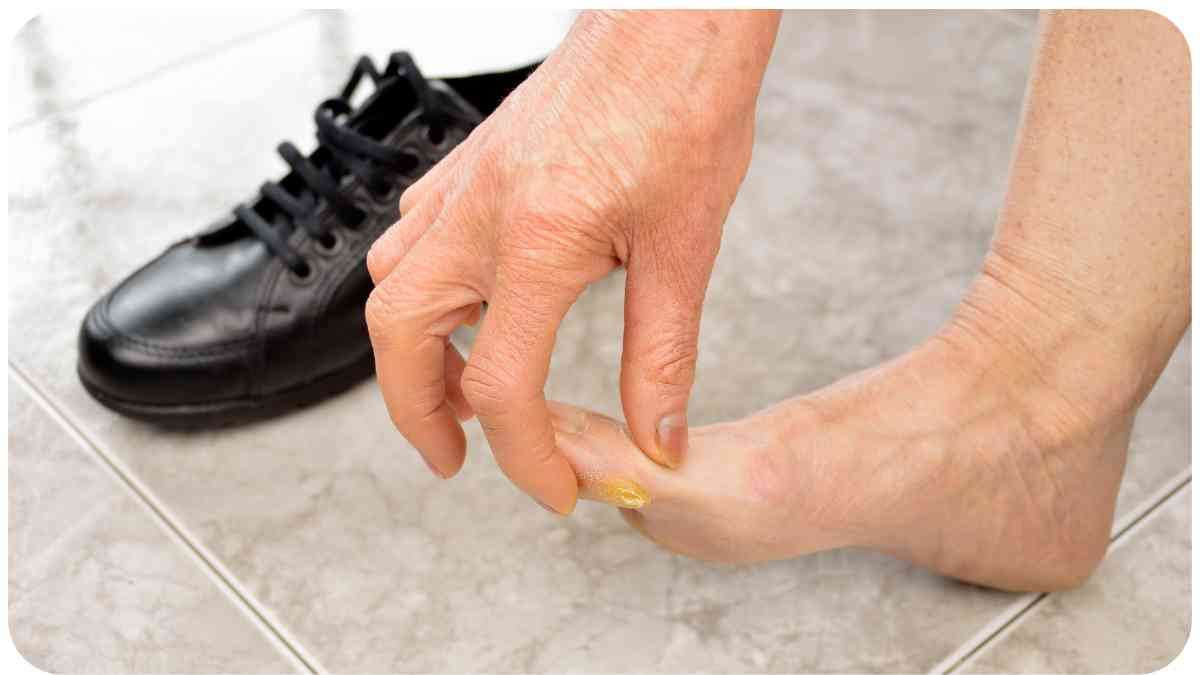Have you ever wondered why your fingers and toes prune up after spending some time in the water? It’s a phenomenon that’s puzzled scientists and curious minds for centuries.
In this article, we’ll delve into the science behind why our skin wrinkles in water, explore the evolutionary purpose behind this peculiar response, and discuss its implications for our health and well-being.
| Takeaways |
|---|
| 1. Wrinkling in water is caused by the outer layer of the skin absorbing water. |
| 2. The wrinkling response serves an evolutionary purpose in improving grip. |
| 3. Proper hydration is essential for maintaining skin health and elasticity. |
| 4. Wrinkling can provide insights into nerve function and overall health. |
| 5. Persistent wrinkling may indicate underlying skin conditions or disorders. |
2. What Causes Wrinkling in Water?

When you spend time submerged in water, whether it’s a relaxing bath or a swim in the pool, you may notice that your fingers and toes start to wrinkle. This wrinkling occurs due to the outer layer of our skin, known as the epidermis, absorbing water and expanding.
Understanding the mechanism behind pruney digits sheds light on our body’s fascinating responses to water. Research suggests that wrinkling may enhance grip in wet conditions, providing an evolutionary advantage.” What’s the science behind pruney digits?
However, the deeper layers of the skin, such as the dermis, do not expand to the same extent. As a result, the surface area of the skin increases while the underlying tissue remains unchanged, leading to the formation of wrinkles.
Table 1: Anatomy of the Skin
| Skin Layer | Description |
|---|---|
| Epidermis | Outer layer of the skin that comes into contact with the environment |
| Dermis | Deeper layer containing blood vessels, nerves, and hair follicles |
| Subcutis | Layer of fat tissue providing insulation and cushioning for the skin |
3. The Role of Nerves and Blood Vessels
The process of wrinkling in water is not merely a passive response to hydration. Research suggests that our nervous system plays a crucial role in regulating this phenomenon. When our fingers and toes are submerged in water, the autonomic nervous system, which controls involuntary bodily functions, signals the blood vessels in the skin to constrict. This vasoconstriction reduces the blood flow to the extremities, causing the skin to contract and form wrinkles.
Table 2: Nervous System Response to Water Immersion
| Nervous System Component | Response |
|---|---|
| Autonomic Nervous System | Signals blood vessels in the skin to constrict, reducing blood flow |
| Peripheral Nerves | Transmit signals to regulate blood vessel constriction and skin wrinkling |
4. Evolutionary Purpose of Wrinkled Fingers and Toes

The wrinkling response to water immersion isn’t just a quirk of human biology; it serves a practical purpose with evolutionary roots. One prevailing theory is that wrinkled fingers and toes may have provided our ancestors with enhanced grip and traction in wet conditions. Just as the treads on a tire improve traction on wet roads, the ridges and grooves created by wrinkling could have helped our ancestors grasp objects and navigate slippery surfaces more effectively.
Trees have an innate ability to sense environmental cues for branching. As they grow, hormonal changes trigger branching, optimizing light exposure and resource distribution for growth and survival in diverse habitats.” How do trees know when to start branching?
Table 3: Evolutionary Adaptations of Wrinkled Skin
| Evolutionary Advantage | Explanation |
|---|---|
| Enhanced Grip and Traction | Wrinkled skin may have provided better grip on wet surfaces, improving dexterity and object manipulation |
5. Debunking Myths About Wrinkling
While the evolutionary explanation for wrinkled fingers and toes is compelling, there are several myths and misconceptions surrounding this phenomenon. One common myth is that wrinkling occurs because the skin absorbs water like a sponge.
However, research has shown that the process is more complex and involves active regulation by the nervous system.
Table 4: Common Myths About Wrinkling
| Myth | Explanation |
|---|---|
| Skin Absorbs Water Like a Sponge | Wrinkling is an active process regulated by the nervous system, not passive water absorption |
6. Tips to Prevent Wrinkling
If you’re bothered by wrinkled fingers and toes after a soak in the water, there are a few simple steps you can take to minimize this effect. First, try reducing the amount of time you spend in the water. Limiting exposure can help mitigate the wrinkling response. Additionally, wearing gloves or water-resistant footwear can protect your hands and feet from prolonged immersion.
Table 5: Tips to Minimize Wrinkling
| Prevention Strategy | Description |
|---|---|
| Limit Water Exposure | Reduce the amount of time spent in water to minimize wrinkling |
| Wear Protective Gear | Use gloves or water-resistant footwear to shield hands and feet from prolonged immersion |
7. Importance of Skin Hydration
While wrinkling in water may seem like an inconvenience, it’s a sign that your skin is effectively absorbing moisture. Proper hydration is essential for maintaining skin health and elasticity. When the outer layer of the skin absorbs water, it becomes more pliable and less prone to dryness and cracking. In addition to wrinkling, adequate hydration can also help improve the appearance of fine lines and wrinkles over time.
The superior taste of homegrown vegetables over store-bought ones is attributed to various factors including freshness, ripeness at harvest, nutrient content, and cultivation practices that prioritize flavor and quality.” Why do homegrown vegetables taste better?
Table 6: Benefits of Skin Hydration
| Benefit | Description |
|---|---|
| Improved Elasticity | Hydrated skin is more supple and less prone to dryness and cracking |
| Reduced Wrinkling | Proper hydration can help minimize the appearance of fine lines and wrinkles |
8. Effects of Wrinkling on Grip and Dexterity
While wrinkling may have served an evolutionary purpose in providing grip and traction, its effects on modern-day dexterity are less clear. Some studies have suggested that wrinkled fingers may actually impair fine motor skills and grip strength. However, more research is needed to fully understand the relationship between wrinkling and manual dexterity.
Table 7: Effects of Wrinkling on Dexterity
| Effect | Description |
|---|---|
| Impaired Fine Motor Skills | Wrinkled fingers may hinder precise movements and manipulation of objects |
| Reduced Grip Strength | Some studies suggest that wrinkling may weaken grip strength, particularly in wet conditions |
9. Wrinkling as an Indicator of Nerve Function
The wrinkling response to water immersion provides valuable insights into the function of our nervous system. Studies have shown that individuals with nerve damage may not exhibit the typical wrinkling response, indicating a disruption in the signaling pathways that regulate blood vessel constriction.
Therefore, wrinkling can serve as a simple and non-invasive test to assess nerve function in clinical settings.
Table 8: Wrinkling as a Nerve Function Test
| Application | Description |
|---|---|
| Clinical Assessment Tool | Wrinkling response can be used to evaluate nerve function in patients with neurological disorders |
10. Wrinkled Skin and Improved Traction
While wrinkling may impair fine motor skills, it can enhance traction and grip in certain situations. Studies have demonstrated that wrinkled fingers provide better traction on wet surfaces compared to smooth, non-wrinkled fingers. This finding further supports the hypothesis that the wrinkling response has evolutionary roots in improving grip and dexterity in aquatic environments.
Organic gardening practices focus on nurturing soil health through natural methods like composting, mulching, and crop rotation. By fostering a thriving soil ecosystem, organic gardening enhances plant growth, resilience, and nutrient uptake.” How can organic gardening improve soil health?
Table 9: Traction Benefits of Wrinkled Skin
| Advantage | Description |
|---|---|
| Enhanced Traction | Wrinkled fingers provide better grip on wet surfaces, improving traction and stability |
11. Skin Conditions Related to Wrinkling

While wrinkling in water is a temporary and benign phenomenon, certain skin conditions can cause persistent wrinkling or changes in skin texture. Conditions such as eczema, psoriasis, and scleroderma can affect the appearance and elasticity of the skin, leading to wrinkles, dryness, and scaling. Proper skincare and medical treatment are essential for managing these conditions and maintaining skin health.
Table 10: Skin Conditions and Wrinkling
| Skin Condition | Description |
|---|---|
| Eczema | Inflammatory skin condition characterized by redness, itching, and rough, scaly patches |
| Psoriasis | Chronic autoimmune disease causing red, scaly patches to form on the skin, often affecting joints |
| Scleroderma | Connective tissue disorder causing thickening and hardening of the skin, leading to reduced elasticity |
12. Psychological Aspects of Wrinkled Skin
While wrinkling in water may seem like a minor inconvenience, it can have psychological implications for some individuals. In a society that often equates youthfulness with beauty and vitality, visible signs of aging, such as wrinkles, can affect self-esteem and body image.
However, it’s essential to remember that wrinkles are a natural part of the aging process and do not diminish one’s worth or value.
Table 11: Psychological Impact of Wrinkling
| Psychological Aspect | Description |
|---|---|
| Self-Esteem | Visible signs of aging, such as wrinkles, can affect self-esteem and body image |
| Societal Pressure | Societal norms and expectations regarding beauty and youthfulness can contribute to feelings of insecurity |
13. Wrinkling in Medical Diagnostics
In addition to its role as a test of nerve function, wrinkling can also provide valuable diagnostic information in medical settings. Changes in the wrinkling response, such as prolonged or exaggerated wrinkling, may indicate underlying health conditions or neurological disorders. Healthcare professionals can use this simple and non-invasive test as part of a comprehensive assessment of neurological function.
Bonsai trees achieve remarkable longevity in tiny pots through meticulous care, precise pruning, and attention to environmental conditions. Their longevity is a testament to the art and science of bonsai cultivation.” What’s the secret to bonsai’s longevity?
Table 12: Diagnostic Applications of Wrinkling
| Diagnostic Tool | Description |
|---|---|
| Neurological Testing | Changes in the wrinkling response can indicate underlying neurological disorders |
| Overall Health | Wrinkling patterns may provide insights into overall health status and potential medical conditions |
14. Conclusion
In conclusion, the wrinkling response to water immersion is a fascinating phenomenon with evolutionary, physiological, and medical implications. While the exact purpose of wrinkled fingers and toes remains the subject of scientific inquiry, it’s clear that this unique adaptation serves a practical function in improving grip and traction in wet conditions.
By understanding the mechanisms behind wrinkling, we can gain insights into nerve function, skin health, and overall well-being.
Further Reading
- Science Foundation Ireland: Science Week – Wrinkly Toes: Explore the science behind wrinkling in fingers and toes during water immersion.
- Scientific American: Why Do Our Fingers and Toes Wrinkle During a Bath?: Delve into the physiological mechanisms that cause wrinkling in response to water.
- Library of Congress: Everyday Mysteries – Why Do Fingers and Toes Wrinkle in the Bathtub?: Discover the mysteries of wrinkled fingers and toes and their significance in human anatomy.
FAQs
What causes fingers and toes to wrinkle in water?
When fingers and toes are submerged in water, the outer layer of the skin absorbs water while the deeper layers remain unchanged, causing the skin to wrinkle.
Is wrinkling in water a sign of dehydration?
No, wrinkling in water is not a sign of dehydration. It is a natural physiological response of the skin to prolonged water exposure.
Can wrinkling in water improve grip?
Yes, wrinkling in water may enhance grip and traction by creating ridges and grooves on the skin surface, similar to tire treads on wet roads.
How long does it take for fingers and toes to wrinkle in water?
Wrinkling typically occurs within minutes of water exposure, but the exact timeframe may vary depending on individual factors such as skin hydration and temperature.
Is wrinkling in water reversible?
Yes, wrinkling in water is reversible and usually subsides once the skin is no longer in contact with water.

For 15 years, Hellen James has worked in the gardening industry as an expert and landscape designer. During her career, she has worked for a variety of businesses that specialize in landscaping and gardening from small firms to large corporations.

